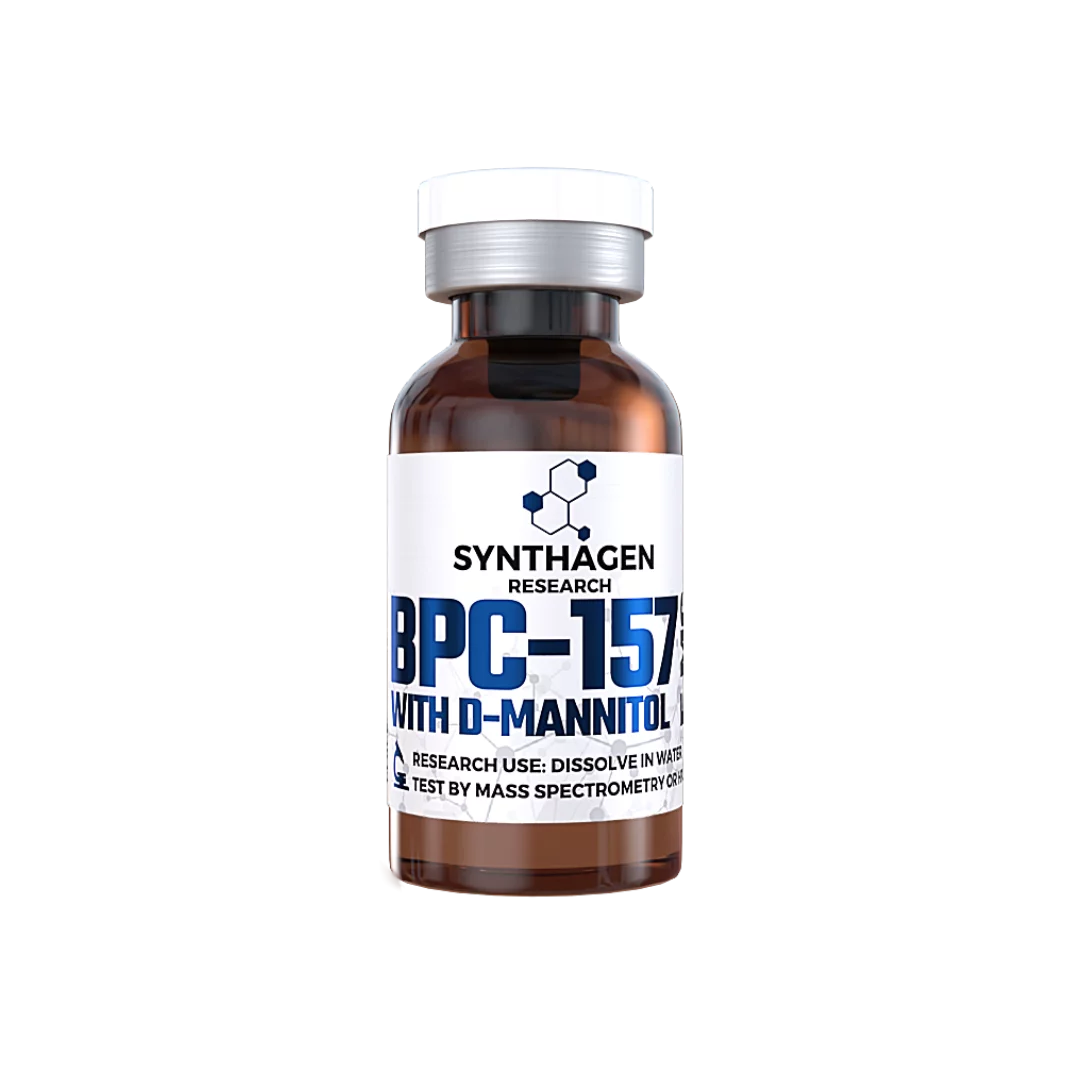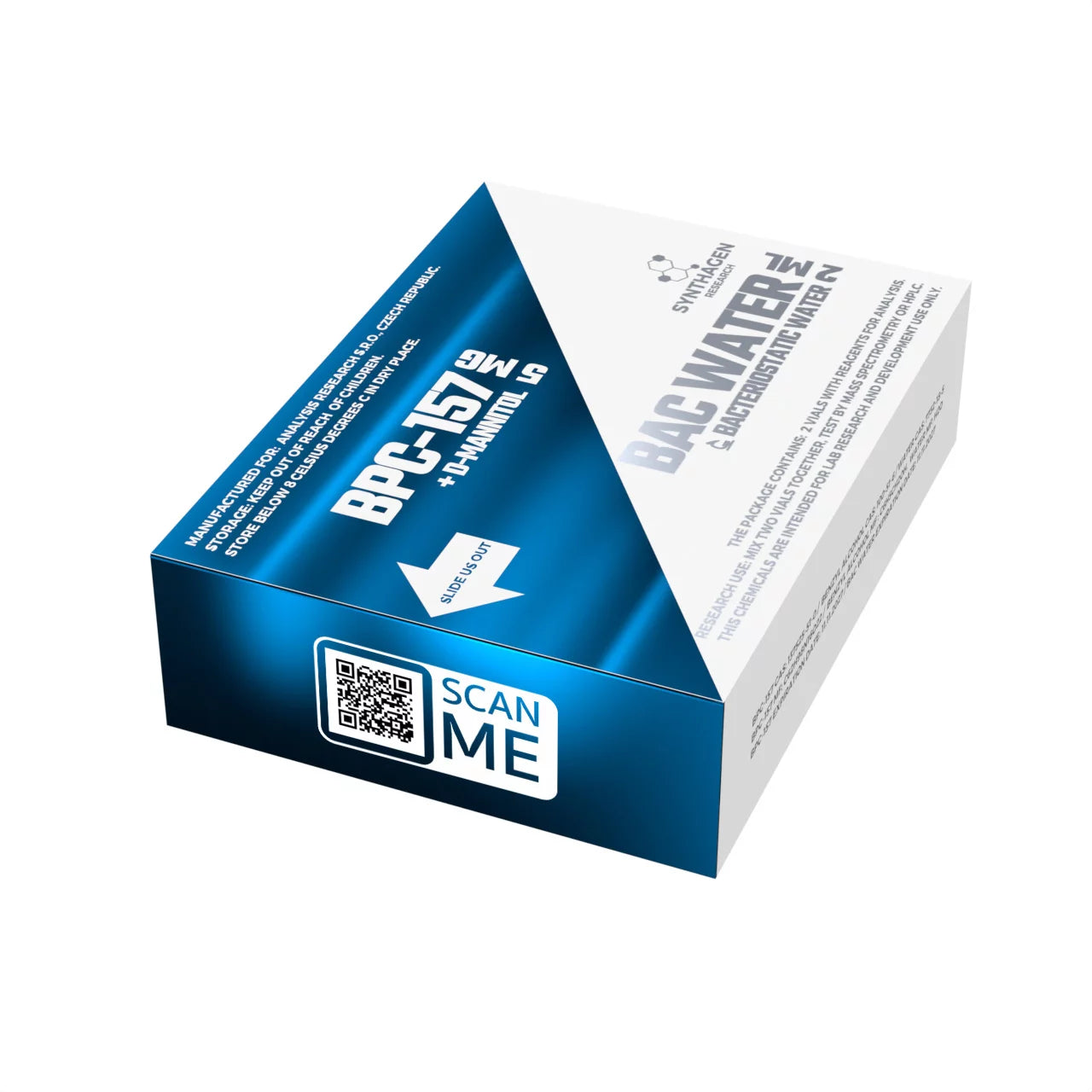WHAT IS BPC-157?
BPC-157 (Body Protection Compound-157) is a synthetic pentadecapeptide derived from a naturally occurring gastric protein.
Its unique 15–amino acid structure was designed to remain stable and bioactive under the challenging conditions of the digestive environment.
BPC-157 demonstrates exceptional regenerative potential, supporting the repair of soft tissues, tendons, muscles, and bones.
Laboratory studies confirm its influence on angiogenesis, collagen formation, and the modulation of inflammatory response.
BPC-157 PROMOTES PROTECTION AND REGENERATION BY:
- Stimulating angiogenesis — enhances the expression of Vascular Endothelial Growth Factor (VEGF), improving microcirculation and accelerating tissue repair.
- Increasing collagen synthesis — supports the regeneration of skin, tendons, and mucous membranes.
- Exerting anti-inflammatory effects — reduces oxidative stress and modulates pro-inflammatory cytokines (TNF-α, IL-6).
- Protecting the vascular endothelium — stabilizes cell membranes and prevents capillary degradation.
- Regulating cellular homeostasis — maintains balance between proliferation and apoptosis, accelerating the repair process.
💡Effect: Faster wound healing, enhanced post-injury recovery, and improved function of the gastrointestinal and musculoskeletal systems.


PEPTIDE STRUCTURE OF BPC-157
- Amino acid sequence: Gly-Glu-Pro-Pro-Pro-Gly-Lys-Pro-Ala-Asp-Asp-Ala-Gly-Leu-Val
- Molecular formula: C₆₂H₉₈N₁₆O₂₂
- Molecular weight: 1419.56 g/mol
- Form: Lyophilized powder (white / off-white), soluble in demineralized water

RESEARCH & BIOLOGICAL ACTIVITY
BPC-157 and Wound Healing
BPC-157 promotes rapid tissue formation and collagen synthesis.
It enhances angiogenesis through increased VEGF expression, improving blood flow and nutrient delivery.
In vivo models demonstrate significantly accelerated healing of wounds, burns, and skin injuries.
BPC-157 and Tendon & Muscle Regeneration
BPC-157 stimulates fibroblast activity — cells responsible for collagen production and tissue remodeling.
Studies show that it increases blood flow to injured areas and improves the elasticity and tensile strength of tendons and connective tissue.

Figure 1. Laboratory study over 7 days. Comparison between untreated control cells and BPC-157-treated cells (1 μg/ml and 2 μg/ml) shows increased fibroblast numbers in treated groups, demonstrating positive effects on tendon healing.
BPC-157 and the Gastrointestinal System
The peptide exhibits strong cytoprotective properties on gastric and intestinal mucosa.
It promotes the regeneration of the epithelial lining, reduces inflammation, and limits excessive gastric acid secretion.
BPC-157 and the Skeletal System
BPC-157 supports osteogenesis by stimulating osteoblast activity and enhancing type I collagen synthesis.
In bone fracture models, it shortens healing time and improves mechanical bone strength.
| Property | Biological Effect |
|---|---|
| Angiogenesis stimulation (VEGF) | Accelerated wound healing, improved tissue perfusion and nutrition |
| Collagen synthesis enhancement | Regeneration of skin, tendons, muscles, and mucous membranes |
| Fibroblast and osteoblast activation | Faster reconstruction of connective and bone tissue |
| Anti-inflammatory action | Reduction of pro-inflammatory cytokines (TNF-α, IL-6) and oxidative stress |
| Endothelial protection | Capillary stabilization and improved microcirculation |
| Regulation of cellular homeostasis | Balance between proliferation and regeneration |
| Cytoprotective effect on GI tract | Regeneration of gastric and intestinal mucosa, protection from damage |
| Enhanced blood flow at injury sites | Improved oxygen and nutrient delivery to damaged tissue |
| Antioxidant activity | Reduction of free radicals, support for natural defense mechanisms |
| Accelerated post-injury recovery | Shortened convalescence and improved healing outcomes |
Bibliography
- L.He, D. Feng, H.Guo, Y.Zhou, Z. Li, K. Zhang, W. Zhang, S. Wang, Z. Wang, Q. Hao, C. Zhang, Pharmacokinetics, distribution, metabolism, and excretion of body-protective compound 157, a potential drug for treating various wounds, in rats and dogs. 2022; 13: 1026182. 10.3389/fphar.2022.1026182
- S.Seiwerth, M. Milavic, J. Vukojevic, S. Gojkovic, I. Krezic, L. Batelja-Vuletic, K. Pavlov, A. Petrovic, S. Sikiric, H. Vranes, A. Blagaic, P.Sikiric, Stable Gastric Pentadecapeptide BPC 157 and Wound Healing. 2021; 12: 627533. 10.3389/fphar.2021.627533
- D.Perovic, D. Kolenc, V. Bilic, N. Somun, D. Drmic, E. Elabjer, G. Buljat, S. Seiwerth, P. Sikiric, Stable gastric pentadecapeptide BPC 157 can improve the healing course of spinal cord injury and lead to functional recovery in rats. 2019; 14: 199. 10.1186/s13018-019-1242-6
- M.Staresinic, M Japjec, H. Vranes, A. Prtoric, H. Zizek, Stable Gastric Pentadecapeptide BPC 157 and Striated, Smooth, and Heart Muscle. 2022; 10(12): 3221. 10.3390/biomedicines10123221
- S.Strbe, S. Gojkovic, I. Krezic, H. Zizek, H. Vranes,I. Barisic, D. Strinic, Over-Dose Lithium Toxicity as an Occlusive-like Syndrome in Rats and Gastric Pentadecapeptide BPC 157. 2021 Nov; 9(11): 1506. 10.3390/biomedicines9111506
- C.Chang, W. Tsai, M. Lin, Y. Hsu, J. Pang, The promoting effect of pentadecapeptide BPC 157 on tendon healing involves tendon outgrowth, cell survival, and cell migration. 201; 110(3):774-80. doi:10.1152/japplphysiol.00945.2010.







